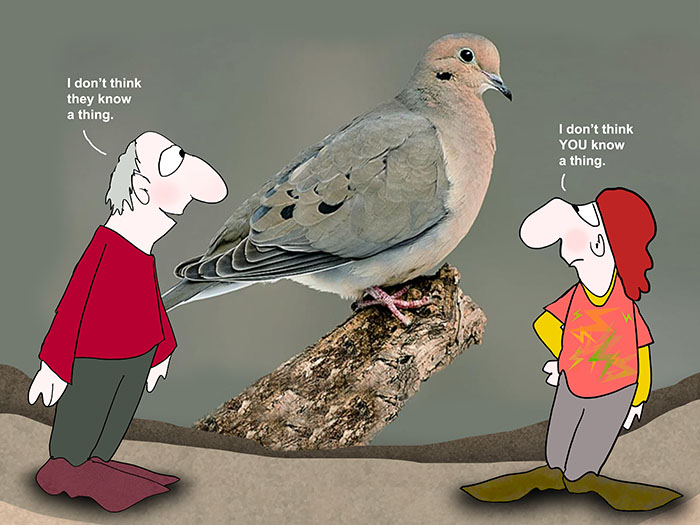A mourning dove hit our windows not too long ago, and the impact killed the bird instantly. It laid there for a little while until we disposed of its body. But in that short time, that it was alone and dead on the ground, I wondered if there was another dove who might be missing its partner at that moment, wondering where he or she had flown off to. You see, mourning doves are monogamous and mate for life.
I’ve told the story before about driving down a country road, nearly 20 years ago and coming upon a squirrel hit. It lay in the middle of the road, dead. But next to it was another squirrel, sitting with its paws on the dead one’s chest, looking at its face. He or she sat by the other and seemed to be waiting. I stopped my car momentarily, wanting to help somehow. Instead, I cried for a long time. The image has not left me.
We, humans, are prone to anthropomorphize animals. We will often assign human thoughts or feelings to their behaviors. Sometimes we even put a voice to what we think are their motivations.
A lot of times, the focus is on cute or funny behaviors. But what about death and dying? What about when animals face the end of life. For hundreds of years, we humans have been fascinated by how it might affect animals. Even Charles Darwin wondered if animals mourned death.
Before I go any further, I have a story from the news last week or so for the naysayers. It was about Magpies who were being studied in their natural environment in Australia. The scientists developed a new tagging system that would use GPS to keep track of the comings and goings of these magpies. Ingeniously, they set up feeding stations where the tags’ batteries would be recharged as they ate. The devices were very light and small, weighing less than a gram.
Within 10 minutes of fitting the final tracker, the team watched as an adult female used her bill to remove the tag clip from another bird in the group. A few hours on, most of the other trackers had been removed. By day three, they were all gone.
The researchers were unclear if one bird figured out how to unlock the devices or whether she taught the others to remove them. Either way. They knew they didn’t belong on their legs by nature, and they acted altruistically to remove those mechanics for one another. Clearly, we have big thinkers among us and not mere bird brains.
There is no doubt that animals think and feel. But. Do animals understand what death is? And do they mourn and grieve, as we do?
Apparently, this is a hard question to answer. But scientists are studying this and trying to understand it. They say that an animal must understand what death “is” before they can grieve. On the other hand, grieving results from missing someone/something intensely. So there is that.
The scientists say that a big difficulty is that “animals can’t verbalize their internal emotions.” Well. I say we are big dumb humans and perhaps those animals are verbalizing perfectly. We are just too thick to understand their words.
Instead, they are studying the concept of grief by parsing out more minor things, such as behavioral responses. They measure behaviors after a “loved one” dies, like decreased appetite, sleep disturbances, reduced sociality, and increased stress. The animal could be mourning as we understand it.
Also, there are “nature” responses to death. Some ants, and termites, bury their dead in little graveyards near the colony. But this is a chemical response, researchers say. Or there are the corvids like crows and ravens. When they find a dead individual, they will begin calling, and loads of other crows will appear. They stand around the dead one. But scientists say this isn’t a crow funeral. They are just trying to gather information about why the bird died to avert future danger. Again, my question. How can the researchers tell the difference? Just because the crows aren’t holding little steins of beer, and singing Oh, Danny Boy?
So what animals most likely mourn? According to researchers, they are whales/dolphins, elephants, and non-human primates.
Whales and dolphins seem to care for dead individuals. Adults sometimes keep dead bodies afloat or carry them on their backs or mouths. Like for a full week.
Elephants. Other elephants will repeatedly approach, touch, and investigate a dead elephant when an individual dies. They will also visit the body over months and years and continue to show interest in the bones.
Chimps, gorillas, and such. They carry their dead infants, for example. They do this for hours or even days. In chimpanzees, they will sometimes hit or pull the body as if trying to wake it up. Other times, they guard the body.
Overall, the science has concluded that these thinking animals do show signs of mourning death.
And I still wonder about that mourning dove outside our window, asking myself if another dove is mourning its loss.
===========
grief is a house
where the chairs
have forgotten how to hold us
the mirrors how to reflect us
the walls how to contain us
― Jandy Nelson, The Sky Is Everywhere
==========
“If you have ever lost a loved one, then you know exactly how it feels. And if you have not, then you cannot possibly imagine it.”
― Lemony Snicket, The Bad Beginning
===========
“Come back. Even as a shadow, even as a dream.”
― Euripides
============
When animals go. How much do they feel?
